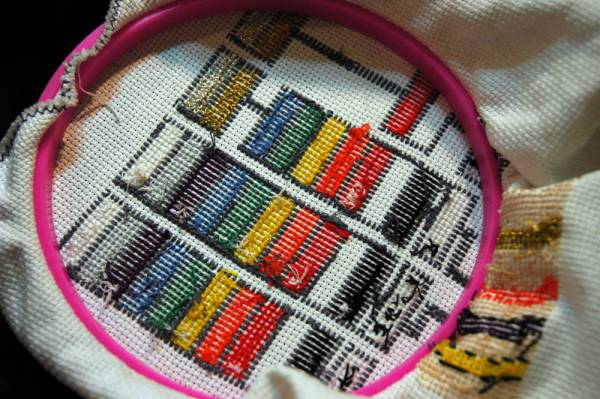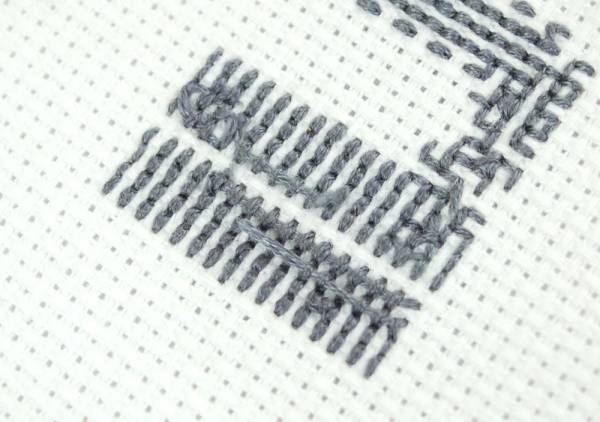This is an old revision of the document!
So you want to learn cross stitch! A great first project is our Ohm Sweet Ohm kit, which is useful for reading resistors after you're done stitching!
 Use Aida cloth for cross stitch– it’s especially woven with openings for your needle between threads. Your needle should not pierce the fabric, but instead pass through these regularly spaced openings. Fold the fabric in half twice to find the center.
Use Aida cloth for cross stitch– it’s especially woven with openings for your needle between threads. Your needle should not pierce the fabric, but instead pass through these regularly spaced openings. Fold the fabric in half twice to find the center.
To prevent fraying edges on your fabric, secure edges with masking tape or a zigzag stitch.
Keep your fabric taut and square while working with an embroidery hoop– we recommend 6” size for most projects.
The hoop has a special lip to grip the fabric extra tight.
Place the solid round piece of the hoop behind the fabric with the lip facing up.
Seat the outer part of the hoop over the cloth and inner hoop. Loosen the screw at the top of the hoop until the outer hoop fits over the fabric and inner hoop.
Tighten the fabric in the embroidery hoop with the fold marks in the center. This is where you will make your first stitch. Pull the fabric taught in the hoop and tighten the adjustment screw as tightly as you can.
Most embroidery floss is made up of six strands. You will not be using all six strands at once. To separate strands, cut an arm’s length of floss and hold with both hands at the midpoint.
Untwist the midpoint of floss and insert your thumbs between the strands, separating the quantity you will need (usually two or three) according to the pattern. Draw your thumbs apart along the length of floss, allowing floss ends to untwist freely.
Some specialty flosses like this metallic floss are made up of 12 strands.
Thread the needle with the number of strands your pattern calls for.
To start stitching, bring the needle from back to front and pull almost all the way through.
Leave 1” of floss (the “tail") at the back.
Hold this tail in the direction you will stitch.
A single cross stitch is comprised of two half X stitches over a square in the fabric’s weave. Stitch from the upper right to lower left.
Then bring the needle from the back to the front again (from the upper left to the lower right), being sure to wrap around the tail in the back, securing it.
This way there are no knots at the back of your project, ensuring it will lay flat on the mounting surface.
Finish the X: stitch from upper left to lower right.
You did it! That's a cross stitch.
You can either make up row of stitches using single cross stitch (completing each stitch before beginning the next one), or you may make a row of bottom stitches, then reverse direction and complete the top stitch of every X. For consistency in appearance, make all first half Xs in one direction (lower left to upper right) and the second half X in the other direction (lower right to upper left). If the floss is tangling or too twisty, let the needle hang freely away from the fabric to let the floss untwist.
Continue to catch the tail on the back as you go.
And that's the basic idea! Continue to follow your pattern to build up your design, changing colors when necessary. The darker pattern grid lines indicate every block of ten stitches so it’s easier to count. You may wish to mark finished rows on the pattern in pencil.
It’s important to wash your hands often while working, as your skin’s natural oils may mark the fabric, especially where it bends over the rim of the hoop. You may wish to fold the excess fabric over the rim while working so your skin is only ever in contact with the back side of the fabric.
Try not to bridge blank spaces in the pattern at the back, especially when working dark colors– they may show through.
Keep the back tidy and knot-free. When 5” of floss are left on your needle, end the strand at the back of the project by sliding the needle under a few stitches.
Carefully clip the strand close to the fabric. To start a new strand of floss, first slide the needle through a few stitches at the back of the fabric to secure the tail.
Move the hoop around the project as necessary to complete all areas of the pattern.
When finished, check the entire project for uncrossed stitches.
 Back stitch - Use back stitching for outlines and text. Think to yourself “two steps forward (at the back of the fabric), one stitch back (on the front of the fabric).” These stitches may be parallel to an axis of the grid, or may oppose it at an angle, but do not form Xs like cross stitches.
Back stitch - Use back stitching for outlines and text. Think to yourself “two steps forward (at the back of the fabric), one stitch back (on the front of the fabric).” These stitches may be parallel to an axis of the grid, or may oppose it at an angle, but do not form Xs like cross stitches.
When complete, take the stitched fabric out of the hoop by loosening the screw and removing both rings. If your fabric does get “hoop marks,” hand wash in warm water with a small amount of color-safe detergent. Rinse first in warm water, then cold.
Even your floss colors bleed into the water, they will not stain the cloth. Lay on a towel to dry. Because I hold my fabric with the technique above, most of my hoop marks appear on the back of the project.
After washing, iron your project between two towels with low heat and steam.
To mount your finished project, either use sticky foam mat board or cut batting to match a rectangle of cardboard. The Ohm Sweet Ohm project fits great in an 8x10" frame. Tape excess fabric around the back and frame, if desired.
Or make a pillow!
Sample Ohm Sweet Ohm project stitched by Bette Day Stern.

































